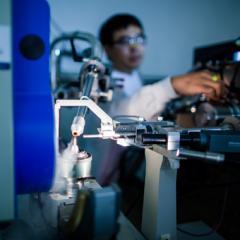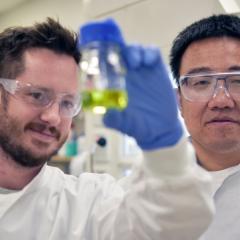Communicating a PhD thesis to a general audience – let alone a live audience – is no easy task.
But that’s exactly what AIBN students Tanika Duivenvoorden, Firasti Sumadi, and Dongxiu (Zoe) Zou did to earn their place in this year’s UQ All-Institutes Three Minute Thesis (3MT) competition.
When the timer starts, the pressure is on – students have just three minutes to explain their research to a general audience, using only the power of their voice and a single PowerPoint slide.
After winning the AIBN heat, Tanika impressed the new judging panel, taking out the UQ All-Institutes 3MT Final and securing her place in the university-wide final later this year.
Her success was followed closely by AIBN runner-up Firasti, whose engaging and entertaining presentation earned her the People’s Choice Award and a spot in the upcoming Wildcard Round – a second chance to compete in the UQ final.
Zoe, AIBN’s original People’s Choice winner, also captivated the audience with her smart gel science and compelling storytelling. While she narrowly missed progressing to the next round, she left a lasting impression.
Together, all three AIBN students showcased the breadth, creativity, and innovation driving research at AIBN - and had the crowd cheering loudly.
Watch their 3MT pitches below.
Zooming in On Batteries for a Better Future - Tanika Duivenvoorden
Inside every battery flows a river of electrolytes, filled with positively and negatively charged particles that enable it to charge and discharge.
After taking out first place in the AIBN heats, and again at the UQ All-Institutes Final, Tanika will now present her cutting-edge research into safer, more sustainable battery materials, at the UQ wide-Final later this year.
“My research focuses on finding new materials that avoid flammable and toxic compounds, so the batteries I make will not only help build a more sustainable future, but a safer one too,” Tanika says.
Using computer modelling, she simulates what the electrolytes inside batteries are doing at an atomic level.
By better understanding how these particles behave, she can find new ways to improve them.
Under the supervision of Professor Debra Bernhardt, Tanika hopes her research transforms the battery industry, supporting the development of cleaner technology and the transition to net-zero emissions.
Cooking Cancer Cells with Sound - Firasti Sumadi
Firasti is finding ways to cook cancer - like popcorn.
A PhD student with Dr Run Zhang, Firasti’s research focuses on using ultrasound-triggered sound waves to spark a chemical explosion inside cancer cells.
Her motivation? Traditional cancer treatments can be painful and debilitating.
“Chemotherapy causes nausea, fatigue, hair loss - and surgery is painful or not always an option,” Firasti says.
“As someone who has watched loved ones go through cancer, I really hope this technology will help people say, ‘I don’t suffer through chemo. I don’t feel pain because of surgery. I cooked my tumour with sound’.”
Her approach uses smart nanoparticles known as layered double hydroxides (LDH). These particles help highlight tumours on scans, and when activated by sound waves, trigger a precise chemical explosion – like the ‘pop’ of popcorn - inside the cancer cells.
Healing from Within: How a smart gel helps grow blood vessels - Dongxiu Zou (Zoe)
Have you ever thought about how a small scratch heals?
Zoe has – and her research is helping us understand how blood vessels regrow and repair damage from the inside out.
AIBN PhD student Zoe wowed the crowd at the AIBN Heats as part of UQ’s 2025 Three Minute Thesis (3MT) competition, with her presentation on smart-gel science taking out the People’s Choice Award.
Under the supervision of Professor Alan Rowan, Zoe is exploring how smart gels can help guide the body’s healing response by encouraging new blood vessel cells to grow. She works with the cells that line our blood vessels, placing them in tiny spheres inside specially designed gels.
These gels are decorated with special molecules that act like tiny hand holders, helping the cells know where to grow, what to grab onto, and how to connect.
“I wanted to understand how we can help the body heal from within, especially in people where the healing process breaks down, like diabetic foot ulcers,” Zoe says.
By mimicking the body’s own healing signals, Zoe hopes her research will one day lead to a gentler, more targeted alternative to drug treatments – helping the body repair itself from within.
“It’s amazing to think that something as small as a molecule can help guide healing. If we can give cells the right signals, we can help the body do what it already knows how to do.”
Congratulations to all the AIBN participants on your outstanding efforts.



